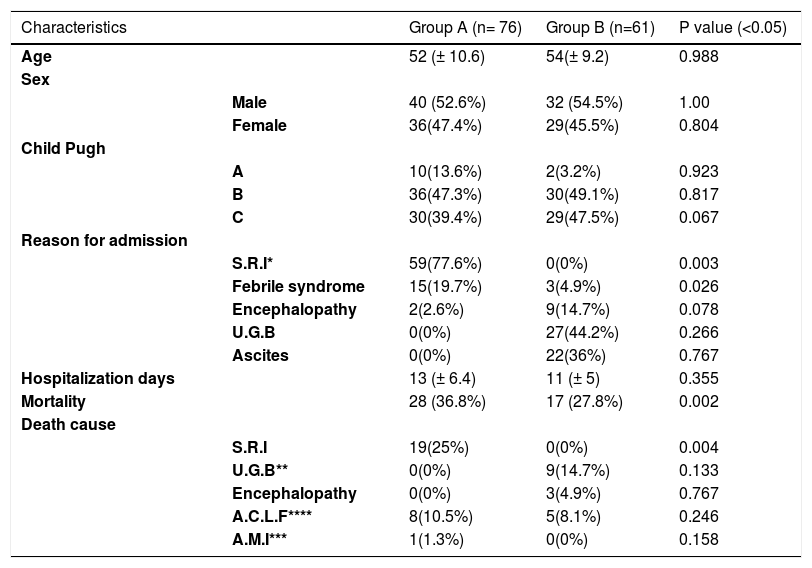
Abstracts of the 2021 Annual meeting of the ALEH (Asociación Latinoamericana para el Estudio del Hígado)
Más datosCOVID-19 represents a great threat in patients with cirrhosis, being a poor prognostic factor. Since the first COVID 19 case in Ecuador 02/29/2020, its impact on cirrhotics in this country is unknown.
AimTo determine the morbidity and mortality of cirrhotic patients with COVID 19. Is it higher in relation to cirrhotics without COVID 19?
MethodsThe present study was multicenter, observational, analytical, prospective and cross-sectional, included 147 hospitalized patients from 2 health units in Guayaquil-Ecuador (Hospital General HOSNAG and Hospital “Abel Gilbert Pontón”), from February 29, 2020 to February 28, 2021. Two groups were established: A, cirrhotic patients with COVID 19; group B, cirrhotic without COVID 19, the following tests were used: Student's T, U Mann-Whitney continuous variables and chi-square, Fisher's exact categorical variables; Statistical analysis was performed with SPSS version 21.
ResultsOf the 147 included, Group A led by male sex 40 patients (52.6%), female sex 36 (47.4%), distribution according to child pugh was 10 (13.6%) stage A, 36 (47, 3%) stage B and 30 (39.4%) stage C, causes of admission were: SRI 59 (77.6%), febrile syndrome 15 (19.7%), encephalopathy 2 (2.6%), average days of hospitalization 13 (± 6.4), associated mortality was 28 (36.8%) most frequent causes of death; SRI 19 (25%), ACLF 8 (10.5%), AMI 1 (1.3%). Group B, male sex 32 patients (54.5%), female 29 (45.5%), child pugh A only 2 patients (3.2%), stage B 30 (49.1%) and C with 29 (47.5%), reason for admission more frequent was UGB 27 (44.2%), ascites 22 (36%), encephalopathy 9 (14.7%), febrile syndrome 3 (4.9%), average days hospitalized 11 (± 5), mortality of 27.8%, causes of death; UGB 9 (14.7%), ACLF 5 (8.1%) and encephalopathy 3 (4.9%) (P 0.002).
ConclusionThe morbidity and mortality of cirrhotic patients with Covid 19 was higher than those without Covid 19.









